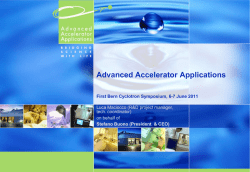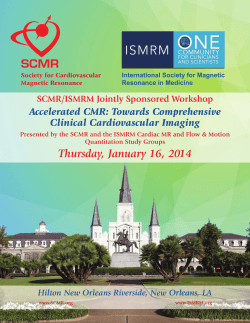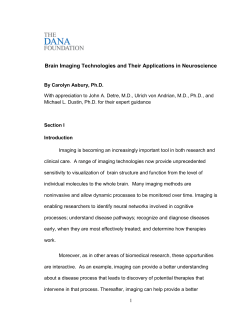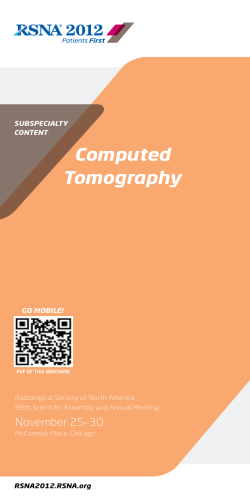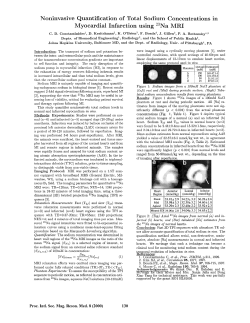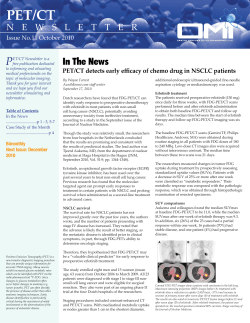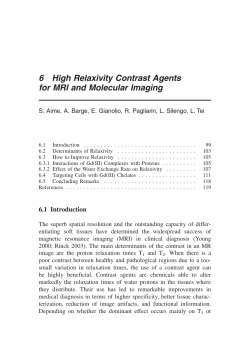
T PrIma C
September 10 – 14, 2012 in Dublin, Ireland – PRIMA IV 2012 The PRIMA Concept 4 Quantitative Image Analysis and Application Specific Imaging The PRIMA Curriculum Concept Curriculum on “Preclinical Imaging in Small Laboratory Animals - PRIMA” The Curriculum aims to satisfy the growing demand for education and training in this field. It`s objective is to train scientists and technologists in preclinical molecular imaging covering current technologies available to monitor rodents in vivo. The curriculum covers basic and advanced theory, including kinetic modelling and quantitative image analysis as well as basic and advanced imaging practice and animal handling. The Curriculum is subdivided into four modules. • PRIMA IV – “Quantitative Image Analysis & Application Specific Imaging” • PRIMA III – “Specific in-depth practical training” (5 days) • PRIMA II – “Introduction to Non-Invasive Small Animal Imaging“ (7 hours) • PRIMA I – “Animal Use & Care“ (3 hours) The idea to establish a Curriculum on “Preclinical Imaging in Small Laboratory Animals” has been arisen from the „Molecular Imaging in Preclinical Research“ committee of the “German Society for Nuclear Medicine - DGN”. In 2011 the curriculum was organised for the first time in cooperation with the ESMI and the “World Molecular Imaging Society - WMIS” with the aim of internationalisation. PRIMA IV – “Quantitative Image Analysis and Application Specific Imaging“ The 5-day workshop on “Quantitative Image Analysis and Application Specific Imaging“ will cover the basic and advanced theoretical background of imaging modalities and contrast agents, quantitative image analysis and kinetic modelling, radiochemistry, and disease specific imaging. Beside the theory teaching sessions and group work will give you the opportunity to go into the depths of imaging analysis - guided by high-level experts and excellent teachers. The focus of the workshop is in advanced probes for Optical Imaging, cutting edge methological applications and sequences in MRI, quantitative image analysis and kinetic modeling, radiochemistry and applied science such as cardiology, neurology, immunology and infectious diseases. The PRIMA Concept The single modules can be attended separately; it is not necessary to attend all four modules. Beside the theory teaching sessions and group work will give you the opportunity to go into the depths of imaging analysis - guided by high-level experts and excellent teachers. Take part in the journal club - analyse, discuss papers, and put your considerations up for discussion. Welcome in Dublin to PRIMA IV – we are looking forward to working with you! The Committee: Nicolas Grenier - Bordeaux, France Fabian Kiessling - Aachen, Germany Twan Lammers - Aachen, Germany Bernd Pichler - Tübingen, Germany Adriele Prina-Mello - Dublin, Ireland Stefan Wiehr - Tübingen, Germany 5 Quantitative Image Analysis and Application Specific Imaging Content The PRIMA Concept 4 Monday 10 September 2012 8 Imaging modalities 8 Optical Imaging: New techniques and approaches for quantitative in-vivo imaging MRI Basics MRI advanced Perfusion Imaging – DCE-Imaging 8 9 9 10 Quantitative image analysis & kinetic modelling 11 11 Quantitative image analysis and kinetic modelling PET: The measurement process, Image reconstruction, calibration, quantitation errors 11 The General PET Compartment Model 12 PET Modelling in Drug Development 13 Wednesday12 September 2012 14 Disease specific imaging – Oncology, Cardiology 14 Disease Specific Imaging – Oncology Disease Specific Imaging - Cardiovascular 14 15 Thursday13 September 2012 Content Tuesday11 September 2012 16 Radiochemistry16 Radiochemistry16 Friday14 September 2012 17 Disease specific imaging – Neurology and Immunology & Infectious Diseases 17 Disease Specific Imaging – Neurology/PET Disease Specific Imaging – Neurology/MRI Disease Specific Imaging – Immunology & Infection Diseases 17 18 19 Addendum – slides of the talks 21 7 September 10 – 14, 2012 in Dublin, Ireland – PRIMA IV 2012 Monday 10 September 2012 I ma g i n g m o d a l iti e s Optical Imaging: New techniques and approaches for quantitative in-vivo imaging Ripoll, Jorge Bioengineering Department, University Carlos III, Madrid, Spain [email protected] Learning objectives • The basis of scattering and how it affects imaging • The effect of autofluorescence • Difference between direct and indirect imaging methods • Different probes available and how their spectrum affects signal to noise In this talk we shall cover the basis of light propagation in order to understand how we can make use of fluorescence to directly or indirectly image molecular processes in-vivo. To that end we shall first cover scattering, what it is, how and when it takes place and its effect on imaging. We shall discuss the absorption spectra of different chromophores in tissue and use it to understand which fluorescent probes are better to image deep in tissues stopping along the way to underline the effect that autofluorescence has on measurements. In order to explain all the above we shall present specific imaging examples, dividing the currently existing imaging approaches into two types: direct and indirect imaging methods. Direct methods represent those in which an image represents directly the distribution of probe (fluorophore in our case) in space; Indirect methods are those in which a numerical transformation or an inversion is needed to recover this distribution in space from a set of data. To show case the direct and indirect approaches and their effect on in-vivo imaging I shall present Optical Projection Tomography and Selective Plane Illumination Microscopy as direct methods, and Fluorescence Molecular Tomography and Opto-acoustic Tomography as indirect methods. 8 Quantitative Image Analysis and Application Specific Imaging MRI Basics Wehrl, Hans Tuebingen, Germany [email protected] Learning objectives Physical Basics of the MR Signal • Necessary Hardware for MR Imaging • MR Coils • Safety in MR Imaging • MR Resonance Principle and Larmor Equation • Longitudinal Relaxation Time (T1) • Transversal Relaxation Time (T2) • MR Image Contrast (T1 weighted, T2 weighted) • Fourier Transformation • MR Image Formation • Pulse Sequence Basics • Application Examples The talk ‘Magnetic Resonance Imaging Basics’ aims to introduce newcomers to the foundations of MR imaging. It also is intended to provide a common basis for the course participants on MR imaging and technology. An introduction into classical spin physics and relaxation principles is given focused on a visual and qualitative description rather than detailed mathematics. Necessary hardware for MR imaging will be described starting from magnets and gradients to different types of MR transmission and reception coils. MR image contrasts such as T1 weighted and T2 weighted are discussed, as well as some of the fundamental acquisition parameters influencing these contrasts will be described. An overview about MR image formation by means of gradients is given, also introducing the Fourier Transformation. Basics about MR pulse sequences are presented. Some application examples of different pulse sequences and MR image contrasts are shown. MRI advanced Augath, Mark-Aurel Zuerich, Switzerland [email protected] Learning objectives • MRI / MRS at High Field Strength • MR contrast and relaxation times • Contrast agents and applications • MR methods and applications Monday 10 September 2012 • The talk is intended to give an insight into some of the most common applications in magnetic resonance imaging (MRI), particularly at high field strengths, as well as an introduction to MR spectroscopy. The advantages and disadvantages of the use of high field systems for different applications are pointed out and the most common technical aspects of image quality improvement at different stages of the image acquisition like efficiency of radio-frequency coils or the use of contrast agents are covered. The generation and the modification of MR image contrast are emphasized. This introduction aims to address the most common aspects of high-field MR technologies and give some background to wide-spread applications. The main purpose of this talk is not an introduction to fundamental MR physics but to deliver a good understanding of the meaning of commonly used terms in MR imaging and spectroscopy and the functioning principles of common MR applications. 9 September 10 – 14, 2012 in Dublin, Ireland – PRIMA IV 2012 Perfusion Imaging – DCE-Imaging Cuénod, Charles A Paris, France [email protected] Learning objectives • Know the general scope and basis of Dynamic Contrast Enhanced (DCE) Imaging • Understand the combination of perfusion and permeability in tissue enhancement • Know and understand the so called perfusion parameters • Know the respective advantages and limitations of visual analysis, semi-quantitative analysis and quantitative analysis in DCE-Imaging • Understand the basis of compartmental modeling in DCE-Imaging • Understand and take into account the temporal resolution and length of the imaging acquisition sequence for the choice of the DCE-Imaging model. Perfusion imaging is gaining momentum in imaging mostly due to the development of Dynamic Contrast Enhanced (DCE) techniques. DCE can be performed with MRI (DCE-MRI), CT (DCE-CT or perfusion CT) and US (DCE-US), and uses the same basic principles, with differences coming only from the proprieties of the respective contrast agents and the types of image acquisition. The signal enhancement of the tissues over time after injection of a bolus of contrast agent depends on the characteristics of the microvascular bed within the tissue and on the characteristics of the kinetic of contrast agent within the feeding artery (measured as the arterial input function AIF). The tissue enhancement curve is the combination of the enhancement due to the presence of contrast agent within the capillary bed and of the enhancement due to the presence of contrast agent within the interstitial space (extravascular extracellular space) due to its leak through the capillary walls. The perfusion parameters of the tissues include the tissue blood perfusion (TBF of FT), the tissue blood volume (TBV) or blood volume fraction (Vb), the tissue permeability x surface and the tissue extravascular extracellular volume (TEV) or extravascular extracellular volume fraction (Ve). These parameters can be extracted from the enhancement curve when using an adequate model taking into account the AIF. Great care, however, has to be taken to use a proper model and extract the parameters that are accessible depending on the temporal resolution and the total length of the imaging acquisition sequence. The presentation will dissect the process of tissue enhancement over time in order to built-up the different types of models used in DCE-imaging and justify their choices depending on the type of acquisition parameters. no 10 s n o i s t e u q tes & Quantitative Image Analysis and Application Specific Imaging Quantitative image analysis & kinetic modelling Quantitative image analysis and kinetic modelling PET: The measurement process, Image reconstruction, calibration, quantitation errors Hallett, William London, UK [email protected] Learning objectives • Underlying physical principles of imaging with positron emitters • Fundamentals of PET imaging technology • Confounding effects (such as randoms, scatter, attenuation) • Methods for correction • Tomographic reconstruction methods • Limiting factors in quantification • Characterisation of imaging performance • Recent developments in technology Tuesday 11 September 2012 Tuesday 11 September 2012 An overview of Positron Emission Tomography in clinical and preclinical applications is presented, from the underlying principles to current developments. Topics covered include the underlying fundamental physical processes, PET scanner technology and its evolution, CT scanner technology as applied to PET-CT imaging, corrections to PET data, methods of reconstruction, limitations of quantification, sources of uncertainty and potential pitfalls in quantification and latest developments in PET technology. 11 September 10 – 14, 2012 in Dublin, Ireland – PRIMA IV 2012 The General PET Compartment Model Cunningham, Vincent Aberdeen, UK [email protected] Learning objectives Tuesday 11 September 2012 • The structure of PET Compartmental Models and how they relate to underlying biochemical, physiological and pharmacological functions. 12 • The relationship between Input functions, Impulse Response functions and Tissue Time-Activity curves. • The macroparameters, K1, KI and VT, in reversible and irreversible models • K1, Blood Flow and Extraction. • KI and glucose utilization in the FDG Model. • VT and BP (Binding Potential) in the Neuroreceptor model. The kinetic behaviour of PET radiotracers in vivo is a reflection of their interaction with the underlying biochemical, physiological and pharmacological functions which govern their uptake and distribution in the organs and tissues of the body. In order to interpret the observed kinetics in blood and tissues on the one hand, and the biological function the tracer is designed to measure, on the other, a tracer kinetic model is required. These mathematical models embody the assumed relationship between the kinetics and the biological function. The analysis of PET tracer kinetics is based mainly on compartmental models or on techniques derived from compartmental behaviour. The compartments usually refer to the ‘state’ of the radiotracer, free or bound etc, rather than, necessarily, differences in physical location. The biological interpretation of the fractional rate constants, linking the compartments, depends on the particular radiotracer being modelled. These rate constants may, for example, embody enzyme activity, as in the case of k3 in the deoxyglucose model, or a combination of pharmacological and physicochemical properties, as in the case of models describing radioligand uptake and binding. The biological interpretation of the particular rate constants, or microparameters, thus plays a vital role in setting up the compartmental models, and deciding whether the model can be a suitable description of the interaction of the radiotracer with the function it is to measure. However, there is no doubt that compartmental models are a simplification of complex biological behaviour, and over-interpretation and reliance on the quantitative estimates of individual microparameters should be avoided. There are combinations of parameters, or macroparameters, which are much more robust, which are independent of particular compartmental configurations, are common across classes of compartmental models, for example reversible, or irreversible, but which can be derived from fitting individual compartmental models. These are Plasma Clearance, Irreversible Disposal Rates and tissue Volumes of Distribution, and these will be illustrated. The general form of reversible and irreversible compartmental models with blood/plasma input functions and corresponding reference tissue models will be presented and discussed. The macroparameters will be related to the general forms of the equation and to observed tissue responses following bolus injection and constant infusion of radiotracers. The role that these macroparameters have played in the classic PET models for Blood Flow, Glucose Metabolic Rate and Radioligand Binding will be emphasised. Quantitative Image Analysis and Application Specific Imaging PET Modelling in Drug Development Cunningham, Vincent Aberdeen, UK [email protected] Learning objectives PET has an increasing role in Drug Development • Pet Studies are of particular value when performed early in the pipeline. • Does the drug reach the target? One can label the drug itself and look at its biodistribution. • Does the drug bind to a target receptor? – label the receptor with a site-specific radioligand at tracer concentrations and see if it is displaced by the drug at pharmacologically relevant concentrations. • Current Emphasis is on Integrating Tissue Uptake Data from PET with Classical PK/PD data – Particularly important in predicting repeat dose occupancy profiles from early single dose data in human subjects PET studies, both pre-clinical and clinical, are playing an increasing role in drug development, being able to provide quantitative answers to a wide range of questions, assisting in Go – No Go decisions early in the drug development pipeline , and establishing dose occupancy relationships for drugs aimed at specific molecular targets. In addition to investigating physiological and biochemical functions such as blood flow, cell proliferation and glucose utilization after drug treatment, it is possible either to label the drug itself, or label its target. Labelling the drug and carrying out biodistribution studies can answer questions such as: does the drug cross the blood-brain barrier? can one extrapolate from preclinical to clinical? is an anti-cancer treatment affecting drug delivery to the tumour? There is now an increasing library of site-specific neurorecptor radioligands, and pharmacological drug occupancy can be estimated from the reduction in the radioligand Binding Potential measured using PET at baseline and post pharmacological dose. If such PET studies are carried out during the course of conventional PK studies, then a composite model can be generated, relating dose to occupancy. The prediction of occupancy after repeat dosing, from single dose PET studies based on compartmental modelswill be considered in some detail. notes & questions Tuesday 11 September 2012 • 13 September 10 – 14, 2012 in Dublin, Ireland – PRIMA IV 2012 Wednesday 12 September 2012 Disease specific imaging – Oncology, Cardiology Disease Specific Imaging – Oncology Kiessling, Fabian Experimental Molecular Imaging (ExMI), RWTH-Aachen [email protected] Learning objectives • Multimodal assessment of tumor growth (including optical methods such as ORI, MEFT and FMT) • Vascular micromorphology assessment • Functional vascular characterisation • Metabolic imaging using • Imaging of apoptosis using • Molecular imaging of endothelial and tumor cell related markers • Theranostics During the last years, molecular medicine has helped us to elucidate pathophysiological mechanisms of cancer and new tumor-specific molecular characteristics could be identified. This has led to the development of new cancerspecific drugs that are now being evaluated in preclinical and clinical studies. However, it also opened the field for molecular and functional imaging. Now pathophysiological characteristics, such as tumor metabolism, cellularity, vascularisation, apoptosis and therapeutic target expression can be assessed non invasively and spatially resolved. MRI, CT, PET, SPECT, optical imaging, and ultrasound are currently playing the dominant role for the assessment of tissue morphology, function and of its molecular profile. Using these imaging modalities in combination with novel contrast agents, targeted probes and theranostics can help us to better understand tumor biology, pathophysiology and therapy response mechanisms. 14 Nevertheless, imaging often is uncritically used and the methods applied are not optimally suited for particular purpose. Therefore, it is the intention of this talk to introduce the major non-invasive imaging modalities and methods used for oncological research in small animals and to give examples how imaging can add important supplementary information to ex vivo analysis and histology. Quantitative Image Analysis and Application Specific Imaging Disease Specific Imaging - Cardiovascular Botnar, René London, UK [email protected] Learning objectives Understand biology of atherosclerosis and post infarct remodeling • Understand basic principles of MR contrast agents • Understand basic principles of cardiovascular MRI • Understand basic principles of MR signal quantification • Understand how proteins or cells can be imaged by MRI in-vivo • Get acquainted with in-vivo examples of molecular MRI • Understand the challenges of human translation Despite advances in diagnosis and treatment complications due to atherosclerosis such as myocardial infarction and stroke remain the number one killers in the western world and developing countries. Current diagnostic tests focus on the detection of lumen stenosis either using x-ray angiography or by measuring myocardial or cerebral blood flow by SPECT, PET or MRI but have failed to predict future cardiovascular events. This is because most myocardial infarctions and strokes are caused by rupture of an unstable atherosclerotic plaque and often occur suddenly in patients without previous symptoms of cardiovascular disease. Autopsy studies have shown that features characteristic for disrupted plaques include a thin heavily inflamed fibrous cap, a large lipid core, large plaque burden, expansive positive remodeling, neovascularization and intraplaque hemorrhage. Other features include dysfunctional endothelial function, endothelial activation, inflammation, extracellular matrix remodeling, hypoxia, activation of proteases and endothelial erosion. To detect these vessel wall changes several new imaging techniques have been developed with MRI and PET being probably the most promising non-invasive approaches for plaque and post infarct remodeling characterization. In this lecture the basic principles of MR imaging of atherosclerosis and post infarct remodeling will be introduced. This will include measurement of tissue properties by use of MR prepulses, visualization and quantification of MR contrast agents, discussion of the basic principles of MR contrast agents and concluding with discussion of motion correction techniques. Several examples of preclinical and clinical molecular, functional and morphological cardiovascular MRI will be presented. Wednesday 12 September 2012 • 15 September 10 – 14, 2012 in Dublin, Ireland – PRIMA IV 2012 Thursday 13 September 2012 R a d i o c h e mi s tr y Radiochemistry Windhorst, Albert & Breeman, Wouter [email protected] & [email protected] Learning objectives • Basics of cyclotron produced radionuclides • Basics of fluor-18 radiochemistry • Basics of carbon-11 radiochemistry • Basics of radiolabeling DOTA- or DTPA-peptides with radiometals, such as 90Y, 111In and 177Lu • Basics of radiolabeling DOTA-peptides with 68Ga • Physical characteristic and production of 68Ga, 90Y, 111In and 177Lu • Specific activity of radiolabeled peptides and the effect on biodistribution, pharmacokinetics, pharmacodynamics and imaging of receptor-mediated processes • Radiochemical limitations of 68Ga, 90Y, 111In and 177Lu-labeled DOTA- or DTPA-peptides, especially for imaging and therapy of receptor-mediated processes • Quality control, radiolysis and shelf life of radiolabeled DOTA- and DTPA-peptides This course will address basic issues in radiochemistry related to the labeling of small molecules and peptides. Most small molecules are labeled with carbon-11 and fluor-18, therefor focus will be on these two radionuclides. Peptides are mostly labeled with radiometals like 68Ga, 90Y, 111In and 177Lu for imaging and therapeutic applications. All radiotracers, despite of their labeling methods, have important characteristics that need to be addressed: specific activity, radionuclide availability, methods to prepare radionuclides, quality control, stability. In addition every radionuclide has its pro’s and cons. All these items will be discussed at a basic level and implications will be shown with examples. 16 Quantitative Image Analysis and Application Specific Imaging Friday 14 September 2012 Di s e a s e s p e ci f ic ima g i n g – N e u r o l o g y & I mm u n o l o g y a n d I n f e cti o u s Di s e a s e s Neurology – Preclinical PET Imaging in Small Animal Disease Models Cumming, Paul ABX Pharma, Radeberg, Germany [email protected] Learning objectives • Give an account of the main limitations of small animal PET imaging • What is small animal PET imaging uniquely suited for. Recent developments in small animal PET (SAP) instrumentation allow reconstruction of images of 1 mm resolution, which is adequate for quantitation of tracer uptake in mouse brain, but with some reservations. This spatial resolution is poor relative to that obtained with quantitative autoradiography. SAP brain studies are subject to the same requirements of tracer specificity and selectivity as is conventional pharmacology. Given the great expense and difficulty of SAP experiments, it is important to consider what SAP may have to offer, which is unattainable by conventional methods. The answer may be that only SAP can provide molecular imaging in studies of longitudinal design. This prospect is exemplified by a number of recent SAP studies of beta-amyloid accumulation in brain of transgenic mice, or in typical studies of chronic versus acute drug treatments, toxicity models, or traumatic brain injury models. In such studies, spatial normalization of serial SAP images from individual animals can best be obtained using multi-model imaging, such as PET-CT. In the first instance, a given PET tracer for brain studies must cross the blood-brain barrier (BBB). In addition to presenting a simple diffusion barrier, the BBB entails active extrusion of certain molecules, mediated by the p-glycoprotein, which is a target of new agents such as tariquidar. Pre-treatment of rats with tariquidar evoked a three-fold increase in the initial clearance of the serotonin 5HT1A receptor ligand [18F]-MPPF. However, the selectivity of p-glycoprotein may differ between species. Furthermore, individual differences in p-glyocoprotein, by altering the permeability of a tracer, may bias the quantitation of its binding in brain. This may also be a factor in the variable phenomenon of pharmacoresistance, as we have seen in a rat epilepsy model, in which poor response to medication with pentobarbital correlated with greater activity of p-glycoprotein with respect to the tracer[18F]MPPF, a co-substrate of the p-glycoptotein transporter. 17 September 10 – 14, 2012 in Dublin, Ireland – PRIMA IV 2012 Friday 14 September 2012 SAP uniquely allows absolute quantitation of tracer uptake in brain relative to a “bloodless” arterial input measured in the heart, i.e. an image-derived input function. This approach affords quantitation of the cerebral metabolic rate for glucose in SAP studies with [18F]-fluorodeoxyglucose (FDG), but with the caveat that general anaesthesia globally reduces brain energy metabolism. Radiotracer synthesis is very expensive, but simultaneous SAP acquisitions in as many as eight mice or two rats reduces the scanning cost per animal. This approach is distinctly advantageous in pharmacological challenge studies, in which a group size of 10 animals may be necessary for adequate statistical power. In the SAP model of psychostimulant action, binding of dopamine receptor ligands is reduced by competition from endogenous dopamine in living brain. As usual, quantitation of receptor binding is limited by spatial resolution, especially given the substantial cranial uptake of [18F]-fluoride characteristic of mouse studies with many [18F]-fluorinated ligands. Returning to the rhetorical question, “When is SAP essential?”, it can be argued that relatively non-invasive molecular imaging is most valuable when individual results are linked to behaviour. Disease Specific Imaging – Neurology/MRI Wiedermann, Dirk Max-Planck_Institute for neurological research [email protected] Learning objectives • Standard imaging protocols in neurology: from anatomical to functional • Quantitative imaging with parameter maps • Correlating imaging and pathology • Longitudinal studies: motion correction and coregistration • Suggestion for complex workflows: pipelines using NiPype In the first part of this talk we will look at standard imaging protocols applied in experimental neurological research: e.g. anatomical imaging, diffusion, perfusion, functional, resting state fMRI… We will then discuss advantages of quantitative imaging for image analysis e.g. T2 weighting vs. T2 parameter map or Diffusion weighted imaging (DWI) vs. the quantitative apparent diffusion coefficient (ADC). Quantitative maps and values can help you to set borders and thresholds e.g. between healthy tissue and the region at risk (penumbra) in the acute phase of a stroke. In the second part I will show some of the post processing strategies we are using in our lab: For acquisitions with multiple repetitions like fMRI or DTI the application of motion corrections can greatly improve the quality of the data evaluation. For human MRI data there are well-established toolboxes like FSL, which can also be used with slight modifications for small animal MRI. Evaluation of longitudinal and/or multimodal imaging usually requires the coregistration of images within the same modality between the different time points or between modalities, if not acquired with dedicated hardware e.g. combined MR/PET scanner. Stefan Vollmer et al. have recently included an experimental feature for automatic coregistration of rat brain PET / MRI in their VINCI program. For more complex data evaluation like DTI or fMRI, workflows usually involve a lot of data transformation, filtering, motion correction and further post processing and evaluation steps. Using the fMRI workflow as an example, I will demonstrate how we have mapped these different steps into one operator independent, fully automatic pipeline using the Python programming language including the NeuroImaging toolboxes NiPype. NiPype combines the flexibility of the Python programming language with interfaces to other programs like FSL (command line), SPM (MatLab) and FreeSurfer. 18 Quantitative Image Analysis and Application Specific Imaging Disease Specific Imaging – Immunology and Infection Diseases Hasenberg, Mike Duisburg, Germany [email protected] Learning objectives • technical background of a) fluorescence microscopy, b) 2-photon microscopy, c) flow cytometry • major cell types of the immune system and their location in the lung • tasks and challenges of computer-based cell-behavior studies During my talk I will focus on different imaging systems which we have established in our institute for the visualization and analysis of cell-cell contacts. I will introduce a fluorescence widefield microscope which is commonly used for in vitro velocity and cell behavior studies. By use of this system I will further demonstrate how it can be employed to observe the influence of spatial environmental arrangements on cellular immune responses. In the second part I will give insights into the emerging field of (in situ) 2-photon microscopy with respect to the exciting field of neutrophil responses towards microbial pathogens. The third part of the lecture will deal with an uncommon application for a flow cytometer. I will explain how such a machine can help to quantify phagocytic events without time consuming microscopy. In the end I will give a short outlook on how PET/MR imaging could help in understanding the immunological and microbial processes under in vivo conditions. Friday 14 September 2012 With the constantly increasing number of immunosuppressed cancer and transplantation patients in clinics all over the world, invasive fungal infections have emerged as severe life-threatening, hardly treatable and expensive illnesses over the last decades. Besides Candida albicans the mold Aspergillus fumigatus is responsible for the second highest number of systemic mycoses in human hosts. The spores (conidia) of this species are ubiquitous and due to their small size and hydrophobic surface they are inhaled by all air breathing animals very easily. Inside the deepest areas of the lung, the alveoli, the immunological fight against the invading pathogen begins. Although many details about these immune responses have been unraveled over time a huge number of basic facts like the importance of different immunological cell types remain unclear until present. One reason for this lack of knowledge is the limitation of visualization techniques used for characterization of these processes. Due to its biological function the lung is under constant movement which is a strong challenge for intravital imaging approaches. 19 September 10 – 14, 2012 in Dublin, Ireland – PRIMA IV 2012 20 Quantitative Image Analysis and Application Specific Imaging Addendum Slides of the talks - working docs Imaging modalities OI: New techniques and approaches for quantitative in-vivo imaging by Jorge Ripoll MRI Basics by Hans Wehrl MRI advanced by Mark-Aurel Augath Perfusion Imaging – DCE-Imaging by Charles A. Cuenod Quantitative image analysis & kinetic modelling Disease specific imaging – Oncology, Cardiology Disease Specific Imaging – Oncology by Fabian Kiessling Disease Specific Imaging - Cardiovascular by René Botnar Addendum PET: the Measurement process by William Hallett The General PET Compartment Model by Vincent Cunningham Image Reconstruction, Calibration, Quantitation errors by William Hallett PET Modelling in Drug Development by Vincent Cunningham Radiochemistry Radiochemistry by Wouer A. P. Breeman Radiochemistry by Albert Windhorst Disease specific imaging – Neurology and Immunology & Infectious Diseases Disease Specific Imaging – Neurology/MRI by Paul Cumming Disease Specific Imaging – Immunology & Infection Diseases by Mike Hasenberg 21
© Copyright 2025

